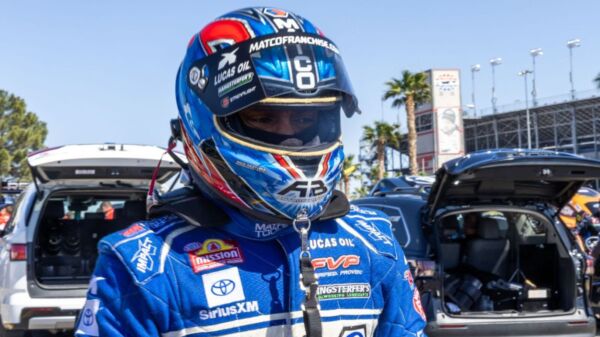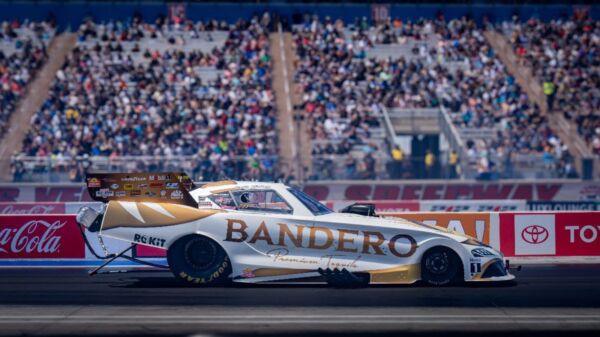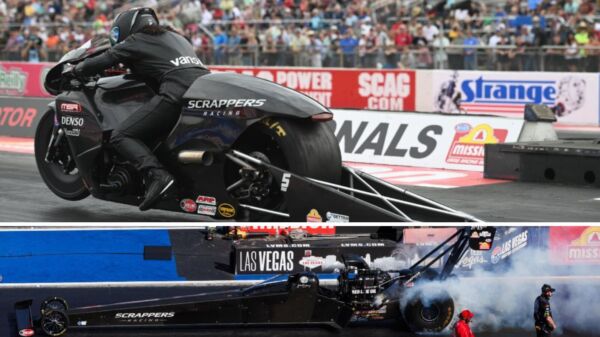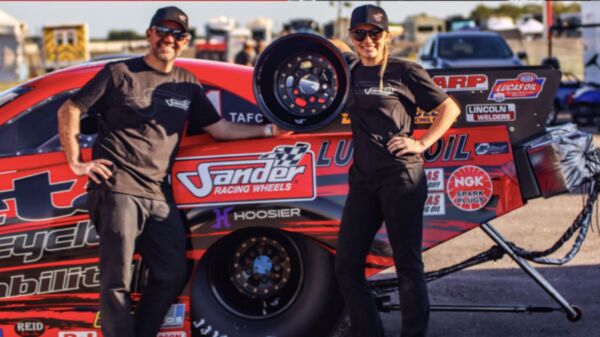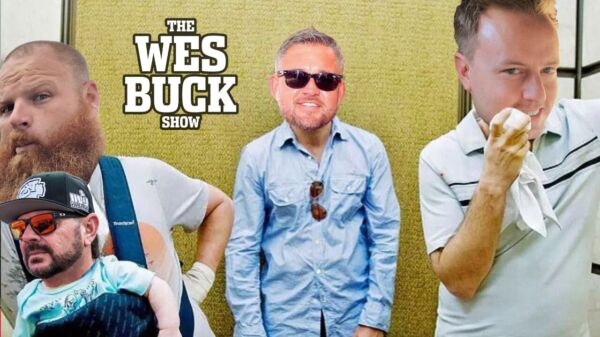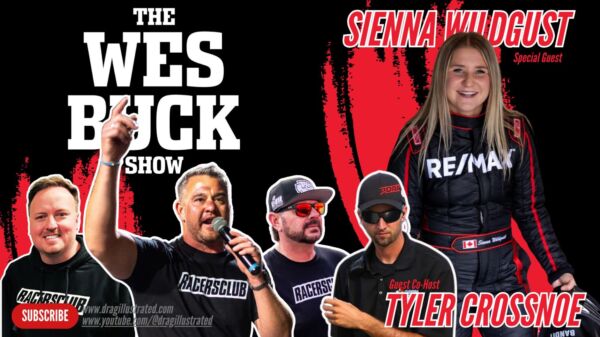Dom Lagana was just a young kid when he saw the circus on wheels. Even at six or seven years old, he was perplexed at what his father, the late Bobby Lagana Sr., was trying to accomplish. They were pulling a Top Fuel dragster on a Dodge Ram truck and one way or another, their father was going to make it work.
“We had to watch out for low bridges so you don’t hit the front end, and we definitely got some weird looks at the border when we would go through, let alone driving across the George Washington Bridge,” Dom remembers. “That was all survival mode, though, which is still instilled in us today.”
[Editor’s Note: This story originally appeared in DI #171, the Crew Chief Issue, in September of 2021.]
It was race by any means necessary and Bobby Jr. and Dom learned early on that things weren’t going to be easy.
Their dragster was rarely competitive from a race standpoint – sometimes going years without even qualifying in the class – but their passion for the sport only grew.
The means to the racing end was often unconventional, but there was something else established that was irreplaceable. It wasn’t about winning or numbers, it was simply about doing whatever it took to get to the next race.
That meant match race after match race just to get enough money to scrape together parts to make it to the next national event. It usually ended with an early loss, but the fire and passion for the sport was established – and it’s never left.
“We still went to the next race with the same enthusiasm as the first race because there’s just something about that nitro car, something about that car rattling back and forth,” Bobby says. “To us, each run we made, even though we weren’t there to compete to even qualify, so to speak, each run and everything that we did mattered so much because we wanted to be able to go back in a month.
“You just enjoy that horsepower, trying to blow you off the ground. It’s hard to explain to people that, this is what drives our life is that nitro car, that horsepower, that rear wing shaking, the rubber, the tire, just hooking up to the right track. And it just drives us crazy.”
Those early days are where Bobby and Dom learned the tuning ropes, knowing when to push forward and when to pull back when making a nice, easy clean run was everything, even if it was a half-second slower than the field.
They also learned about what it meant to receive a helping hand, something that shaped them to be so willing to give back.
These days, they’re part of the dominant force in racing, key members of the gargantuan success story that is Torrence Racing.
 Richard Hogan and Bobby call the shots on Steve Torrence’s dragster, which has scooped up wins at an otherworldly pace. Dom is a key member, too, working closely with the entire two-team car, including Billy Torrence’s dragster.
Richard Hogan and Bobby call the shots on Steve Torrence’s dragster, which has scooped up wins at an otherworldly pace. Dom is a key member, too, working closely with the entire two-team car, including Billy Torrence’s dragster.
Both Laganas and the man known as “Hoagie” spearhead the operation of a team that has stayed largely intact for nearly a decade. The culture, the intuition, the mix of old-school and technology, all play a part in Torrence sweeping three straight world titles and possibly a fourth this season.
He’s closing in on 50 Top Fuel wins, a mark for the Texan that seemed unheard of just a handful of years ago.
Years after toiling just to make it to a race, the Laganas are now at the top of the sport, while Hogan, who has worked for greats like Dale Armstrong, Kenny Bernstein, and Don Garlits but is as soft-spoken as they come, has made a legendary name for himself while steering clear of the spotlight.
Hogan calls this stop the last place he’ll ever work, and it’s a dream scenario for all involved.
“The guys just take care of everything. I don’t have to worry about much,” Hogan says. “We’ve all worked together for so long now. Everybody’s happy here. I don’t micromanage anything. When you get to a position where it works like this, you just go along with it.”
Both the Laganas have battled back from near devastating adversity, with Bobby enduring a horrific crash in the family’s Top Fuel dragster and Dom battling back from a near-tragic non-racing accident near Lucas Oil Raceway in Indianapolis a year ago.
His emotional journey to recovery – which included more than a month in a coma, 100-plus days in a burn unit, and having both legs amputated – touched the racing community and again showed the tremendous resolve the brothers have shown throughout their lives.
They talked to Drag Illustrated about what has made their journey so special, paying it back, and their appreciation for Hogan and the finer aspects of nitro racing, while Hogan also dished on the nuances of tuning an 11,000-horsepower machine, man versus machine and what has made this team so special.
What were some of those early lessons that your father taught you that had a strong influence on your racing and tuning?

Bobby Lagana (Joe McHugh photo)
BOBBY LAGANA: He was a smart guy and could build anything. We would do a lot of match racing and get paid to put on a show, and that money would break him even for the weekend, and then he would run a couple of national events just to represent, but we never, typically, would qualify. But that kind of got the bug in us kids, and as we got older, we started becoming active and understanding the mechanics of the car.
We were just fortunate, the way we grew up with our parents, and our dad, he was a very, very mechanically inclined person. He was a guy that could set up a rear end, and everybody came to him. He would put together a clutch, didn’t have all the precision measurement tools, but if you use the tools after he set it up, you would think he had it because everything he did was perfect. So he just taught us to be good mechanics and pay attention to detail, and that’s kind of the motto that we live on here at Torrence Racing.
DOM LAGANA: Really, forget the racing side of it. I just learned survival skills that I still attribute to my life nowadays, and it taught us how special family is out here. My dad would come out and race and he didn’t have a competitive car by any means. He always wanted it to look nice and run to the best of the capabilities that the parts would allow. We went six, seven years sometimes without qualifying at a race, but he wasn’t upset. He had a smile pulling into the race because we learned how to enjoy racing for what it is, not just the success part of it.
BOBBY LAGANA: Honestly, the most important thing that is still the same thing that our dad taught us, is basic mechanics and pay attention to detail, and knowing when you can put a team together that all have that same understanding and value of that is when you can succeed. There are so many judgment calls and instinctual things that you have to do as a tuner and when you can have a team like we do here, where you can rely on your guys to talk to you about each section of the car, and talk to you about what they think maybe is going on, it just helps the tuner make a good call.
Richard, you saw those situations with the Lagana family from afar, certainly not knowing you would race together down the road. But what stood out with what they were trying to accomplish?
HOGAN: It just reminded me of some of the situations I’ve been in over the years when I was younger with the match races, doing whatever it took to generate money. I worked for a lot of teams that were real limited budgets over the years and then I also worked for someone who had the best funding, so I’ve seen both sides of it. There was just so much passion there for racing. If Bobby had a place to live at the racetrack, he probably would have.
By the time the Laganas joined Torrence Racing in 2013, they had firmly established themselves in the sport, predominantly as guys who had an unwavering desire to race, tune and be around the sport as much as possible. Dom was campaigning the family’s popular “Nitro Ninja” dragster, both had gone well over 300 mph and each seemed to be having the time of their lives.
But things changed almost overnight. While Torrence wasn’t an instant sensation, it didn’t take too long before the team was clicking and reaching heights nobody expected or thought possible.
It was a whole new world for everyone involved – Bobby, Dom, and Hogan – but a sense of togetherness reigned supreme.
The way this team works together is something special. What stands out to you about the way this team just flows together seemingly so perfectly?

Richard Hogan (Cole Rokosky photo)
BOBBY: Hoagie’s an instinctual type of tuner. So he’s the kind of guy that likes to make last-minute calls and he needs to have all the confidence that everything is done right. When the guys know that they can approach him and say, “Hey, this looks different,” or, “This is going on,” and their opinion matters, that really, just for the whole team, that changes your reason for being there.
Now, when the car goes and makes a good run, your celebration is not just for the team, it’s also for the job that you did. You want everyone to buy into the idea of the whole team is one. There’s not just an individual here that does a better job than anybody else. Each job is so important, and if everybody does everything perfectly, but one guy doesn’t, then nothing matters anymore. That’s the hardest thing to teach to people, is how much do you care. There’s a deep respect for each person’s life, not just in what they do on the race car.
HOGAN: I show up at the racetrack, do whatever I do, and then go home, and it couldn’t be any better. There’s no ego over here. I don’t care if it’s the tuner or whatever it is, there’s no competition between us to make the calls or the decisions. If you get to where you’re just a guy in charge, and that’s the way it is, that’s not good. You work with everybody and you’ve got to challenge each other.
There are guys on this team certainly capable of tuning for another team or enough talent to work into a role like that. But this team has stayed intact for several years, which is a huge rarity in this sport. How has that happened?

Dom Lagana (Cole Rokosky photo)
DOM: Everybody out here, they put the hours in, the blood, sweat, and tears, and everybody works hard. But the family atmosphere that we grew up in and brought to these teams, and the family atmosphere that Billy, Steve and Kay allow this team to be run as I truly think is a vital part of our success and all the guys gel. When we were growing up, even seven, eight years ago, when the Ninja would come out, I loved doing bottom end. I didn’t care. I’d do bottom end, I’d strip blowers, build motors, do heads, whatever. I’d clean oil pans – all stuff that needed to be done and all that stuff resulted in the car running better. There were no job titles in our team and that’s kind of how we are here.
Every guy on this team is pretty well-rounded with every area of the car. They each have their areas, but a guy on these teams doesn’t say, “All right, my cylinder heads are serviced and done, I’m going to go sit outside.” When somebody’s done with their job, they’ll go help the other guy. Nobody has an ego is what I guess I’m saying. All they want is the best result for these cars to run well.
BOBBY: There are guys on our team, 100 percent, that could go and work on another team, and instantly move up the so-called ladder, which we try to stay away from that here, too, you know? Everybody is so important. We’ve been together for so long, it’s not a part of your daily thought process of, “How do we rebuild or how do we get it back?” All of us here just always march forward.
With the team clicking, Torrence hit his stride in 2016, winning three times that year. It was a mere preview of the domination that would come. They won eight times in 2017, followed it on the vengeance tour in 2018, winning all six races in the Countdown to the Championship to claim their first world title. The Torrence Racing team has won 49 times since the start of 2017, a staggering number considering Billy hasn’t raced a full season in that time. But as the spotlight has grown, the team’s approach hasn’t changed. It’s a mix of new-school and old-school, with Hogan relying on the methods that made him successful with Garlits long ago, but not afraid to dig into the computer.
Add in the instinct each of them has and it’s an incredible combo that nobody has come close to matching in five years.

Rick Belden photo
How does an old-school approach work for this team and what does that mean in this day and age?
BOBBY: Dom and I have been able to be around some really good crew chiefs in this sport, and Hoagie has been the biggest influence on myself and Dom’s understanding of a nitro car and how you want to run one. When I got to work with him, to see that he was still an old-school guy that cared about mechanics, and he also wanted to inject himself into the guys’ roles on the race car, and help out and use his knowledge to make them better, that was an instant click.
He’s able to be successful with an old-school mentality. I think that’s what made the team click in the beginning was that he was old school, and we were able to see that right away.
He’s a bearing and spark plugs guy and he likes to walk the racetrack himself to get his final feel of the racetrack. It’s all the basic mechanics that matter to him. When you’re the crew chief of this car, with the amount of technology available to you, it’s easy to get lost, and it’s easy to forget about the basic mechanics. But he’s still an old-school thinker. He still relates his days with Big Daddy to some of the decisions that he makes or the things that he wants to look at, and Big Daddy was the ultimate old-school mechanic, tuner, and driver.
The thing that can separate Hogan is, not only is he old school, he still has that aggressive mentality of wanting to run hard. Certain parts of the racetrack are really important to him as far as performance. That aggressive mentality, that’s hard to learn

Joe McHugh photo
HOGAN: The years I spent with Garlits were a huge influence because obviously, he owns computers, he drove, he tunes, we both hauled everything around the country, and then I was lucky that I worked under some really good chiefs. It wasn’t as much as the old school because they did everything by the seat of the pants. It’s just different, how you drove was different. So I’d get lucky to be around some talented tuners and drivers.
I’ve seen it backfire so when you get into this position you fall back on what you know and don’t be hell-bent on the technology end of it. I don’t know if this is going to save you. There’s a fine line there on how much technology you can use.
It’s almost always clutch-related. There are some fuel system adjustments, but that’s not quite as critical anymore and it’s pretty much all clutch.
 DOM: Hoagie has the approach that my brother and I had with our dad. Before you even look at the motor, what does the bearing say? What do the pistons look like? What do the spark plugs look like? The car is going to talk to you. We take that coupled with the data and the stuff that we’re fortunate enough to have now. It’s an old-school approach and that’s how we grew up and that’s how Hogan is. We enjoy that. When you’re running 3.60s and 3.70s, you’ve got to have good parts in there, but he’s real big on he’d rather have it clean and run a few hundredths slower, than go set the world record and hurt it. From where we came from, we can definitely appreciate that.
DOM: Hoagie has the approach that my brother and I had with our dad. Before you even look at the motor, what does the bearing say? What do the pistons look like? What do the spark plugs look like? The car is going to talk to you. We take that coupled with the data and the stuff that we’re fortunate enough to have now. It’s an old-school approach and that’s how we grew up and that’s how Hogan is. We enjoy that. When you’re running 3.60s and 3.70s, you’ve got to have good parts in there, but he’s real big on he’d rather have it clean and run a few hundredths slower, than go set the world record and hurt it. From where we came from, we can definitely appreciate that.
Part of what’s been instilled in the Laganas is a willingness to help. Even with the team dominating atop the Top Fuel ranks, they’ve never failed to remember where they came from. They’ve reached out to countless teams, much like the likes of Mike Kloeber and Clay Millican, Luigi Novelli, Doug Herbert, and others did with them while Bobby was racing and Dom was campaigning the “Nitro Ninja.”
These days, the Laganas and the team offer their assistance and expertise to several teams, including Scott Palmer, Krista Baldwin, and in a cool full-circle type of way, Novelli. They worked with Tripp Tatum on building his new car, the latest in a long line of returning the favor from teams that helped them out years ago.
You’ve had a hand in helping a pretty significant number of teams. Where does that willingness to help other teams come from?

Billy Torrence (Rick Belden photo)
DOM: First and foremost, it comes from Kay and Billy, and Steve to allow us to help. They want to help these guys, too. They love helping because we need the cars there, and for sure it comes from me and Bob. When Bob had the crash and it destroyed everything, and once he healed up, it’s like, “All right, we’re going to try and race again.” We bought an old chassis and a guy like Luigi Novelli, every other week, a package would show up – input shafts or pistons or rings or whatever it may have been. Luigi would tell us not to quit, don’t let this knock you down. He supported us and we made it back, so we try and help these teams out here because, in racing, the more cars we get the better, and I know firsthand the situation of being a broke guy, trying to scrape by going through garbage cans, making it work.
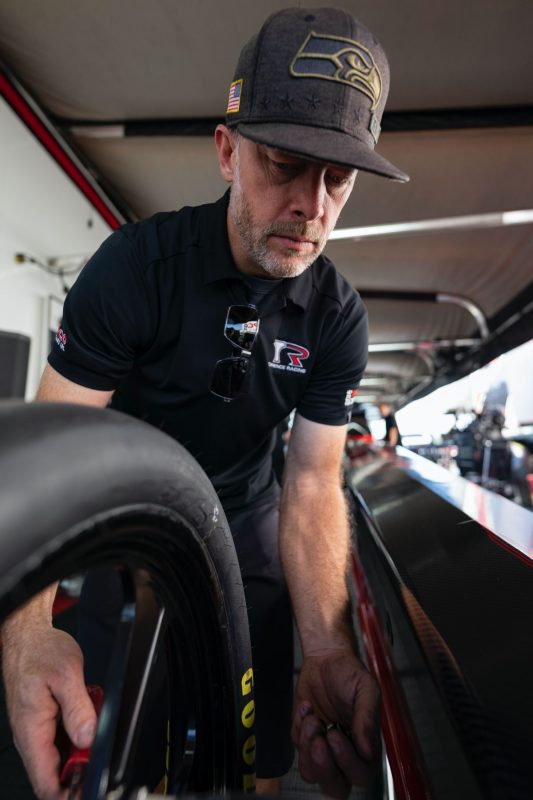 When we started upgrading our equipment, we didn’t understand what exactly to do. In the early 2000s, when Clay and Mike were the kings of IHRA, they steered us in the right direction because we were blowing up motors. We didn’t understand how a fuel management system worked because we never had one. We didn’t have a modern barrel valve, and hell, they rolled us over motors sometimes. They were in the championship hunt, fighting for it and you got these idiots running off a Ram truck. These guys took one of their spare motors and rolled it down to us because they just wanted to help us. There were definitely a few times where we went out there and kicked the rods out, and Clay and Kloeber brought us out of the ashes. If that didn’t happen, who knows what. You’ve got to remember where you came from. I for sure do. My brother for sure does. That’s where that drive comes from. You’ve got to help people.
When we started upgrading our equipment, we didn’t understand what exactly to do. In the early 2000s, when Clay and Mike were the kings of IHRA, they steered us in the right direction because we were blowing up motors. We didn’t understand how a fuel management system worked because we never had one. We didn’t have a modern barrel valve, and hell, they rolled us over motors sometimes. They were in the championship hunt, fighting for it and you got these idiots running off a Ram truck. These guys took one of their spare motors and rolled it down to us because they just wanted to help us. There were definitely a few times where we went out there and kicked the rods out, and Clay and Kloeber brought us out of the ashes. If that didn’t happen, who knows what. You’ve got to remember where you came from. I for sure do. My brother for sure does. That’s where that drive comes from. You’ve got to help people.
We’re in a fortunate position right now and the Torrence family wants us to help people.
BOBBY: It was a lot of teams that helped our little team stay in business. To watch that drove me and Dom for sure. Once we started building up our inventory and our knowledge, we always try to spread. It was never for a self-serving issue. It’s always for the betterment of the sport, especially right now where our sport needs as many cars that are here to put on a show. You’re the show. The fans are paying for header flames to the finish line. And I believe that in NHRA drag racing as well.
You want fans to come and have the least amount of negative memories in their head of the weekend, and if most of the cars make it to the finish line, that’s what they want to see. They want to see close side-by-side racing, but most important is finish line runs. I understand all the rest of the classes are important to our sport, but the nitro classes are, some people might say, the biggest part of the show. When 11,000 horsepower is side-by-side, both of them, 22,000 horsepower, rattling back and forth, and the car is doing 100 mph in eight tenths of a second, that’s pretty impressive. If you’re just a person that doesn’t even know one single thing about an automobile, and you watch that car go down the track, you’re going to be in awe.

Joe McHugh photo
The team also rallied around Dom following his near-tragic accident last year. It wasn’t surprising, but it somehow brought the team even closer. Dom made his triumphant return earlier this year and while the success never wavered when he was going through his life-changing procedures, having him back once again made the team complete again.
“It was just the brotherhood that I knew we had, but that everybody showed me,” Dom says.
“They missed me. The reason we get so excited is that any win could be your last. Success is never guaranteed. Everybody knows we have the air horn (that the team uses to celebrate following a victory) and once I had my accident and I was not at the races, they won some races with Steve’s car and they would not honk the air horn because I loved that thing.
 “It’s stupid stuff like that,” Dom continues. “But it was the brotherhood here, the camaraderie, the support that all the guys showed me. It was a driving force, laying in a hospital bed with no legs and skinny like a twig. My [wife], Sara, obviously showed me so much strength, and these guys, they wanted me back. They said, ‘We need you back here,’ even though they won a championship. That was big for me and a big thing mentally, to have something to come back to, just to drive you on those hard days. They made me feel like I was part of the puzzle. I appreciated it because I’ve sacrificed my whole life to drag racing and I love it. It’s my passion. For them to say we need you here, it was a driving force, and to be able to win races with Steve’s car and to be able to win two races with Billy’s car, I cannot complain at all. I’m so lucky.”
“It’s stupid stuff like that,” Dom continues. “But it was the brotherhood here, the camaraderie, the support that all the guys showed me. It was a driving force, laying in a hospital bed with no legs and skinny like a twig. My [wife], Sara, obviously showed me so much strength, and these guys, they wanted me back. They said, ‘We need you back here,’ even though they won a championship. That was big for me and a big thing mentally, to have something to come back to, just to drive you on those hard days. They made me feel like I was part of the puzzle. I appreciated it because I’ve sacrificed my whole life to drag racing and I love it. It’s my passion. For them to say we need you here, it was a driving force, and to be able to win races with Steve’s car and to be able to win two races with Billy’s car, I cannot complain at all. I’m so lucky.”
Ultimately, the Laganas and Hogan know they’re in a special position and it’s not something they take for granted. The journey has been special and even as the goals have changed, their outlook has not. There’s still a love for nitro racing, working together, and living the racing dream every day.
“I’m very complete with this, what we’ve been able to accomplish,” Bobby says. “I enjoy that we’re able to do this together, and that we all still respect each other, and that guys could go elsewhere, but their choice is to stay together and race together. That’s what drives me. And then when you watch that car go down the track, it’s just something that, I don’t know what it could be replaced with. You look back and you say that you would just do it again completely for free, just to be a part of a car going down the racetrack.”


